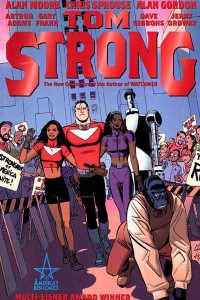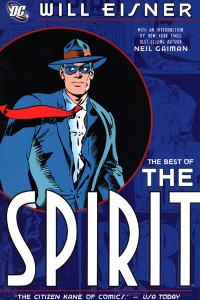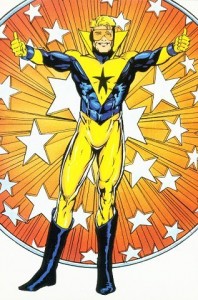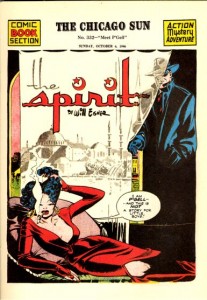Graphic Novel Review: Tom Strong by Alan Moore and Chris Sprouse
 Every medium has its strange little quirks. Odd little rules of the form that have developed and that creators rarely deviate from.
Every medium has its strange little quirks. Odd little rules of the form that have developed and that creators rarely deviate from.
For example, it is rare for a movie to have a plot that unfolds in real time. Television shows are limited in length by half-hour increments, allowing, of course, for commercials. You may see a program that’s 15 minutes long, but never 45 minutes.
It’s theoretically possible to have a show be 20 minutes long or a movie that is in real time, but it’s rarely if ever done in practice.
Comic books are no different. They have their own rules and standards that creators are obliged to follow.
One of the most peculiar things about sequential art as a medium is that it is largely devoted to a single genre – superhero action/adventure.
There are certainly lots of comics that do not involve capes or tights. But the vast majority of the comics produced in this medium prominently feature superheroes.
It wasn’t always this way. In the aftermath of the Second World War, superhero titles began to disappear off the rack. Only Batman, Superman and Wonder Woman survived in any form. Titles like Captain America, Captain Marvel and Green Lantern were replaced by Westerns, Romances and especially horror books.
However, as the Silver Age dawned with Showcase #4 and Fantastic Four #1, superheroes came back in to vogue. DC and Marvel plunged into producing cape and tights stories almost whole hog. Even characters that were of other genres like Nick Fury, Jonah Hex, Mille the Model, Patsy Walker and the Two-Gun Kid were folded into their mainstream continuity.
Since then, the medium and the genre have been inexorably linked. Sure, there are still some comics that do not feature superheroes, but they are few and far between.
It would be like if CBS and NBC’s programming was almost entirely police procedural dramas.
All this serves a lengthy preamble to talk about Alan Moore’s America’s Best Comics, an attempt by the famed author to break free from the superhero genre. He introduced books like Top 10, Promethea and Greyshirt that were departures from the usual comic book fare.
The most prominent work in the ABC line was Tom Strong, an analog of Doc Savage, Tarzan, Tom Swift and other pulp-styled heroes of the early 20th century.
Although still definitely an action-adventure story, Tom Strong is not a crime fighter or vigilante of any sort. His primary interest is science and education. He’s constantly inventing Swiftian devices that, predictably, become useful in his latest adventure. He is a utopianist devoted to improving his world.
Of course, Strong is often beset by villains who want to destroy his hometown of Millennium City or kill him to avenge an earlier defeat. Enemies like Nazi air pirate Ingrid Weiss, technological plague the Modular Man and Strong’s arch-nemesis Paul Saveen plague the hero and his family.
They’re all fun, off-beat characters that can make you laugh while remaining threatening to the safety of Tom Strong and his extended family.
As always, Moore does a fantastic job of developing characters quickly and creating entertaining traps for Strong to unravel, all while maintaining the traditional sense of fun inherent in all pulp fiction.

Chris Sprouse's incredible work on Tom Strong. Tom Strong is conceived as Pneuman the Pneumatic Man watches on.
Chris Sprouse’s artwork shines. It’s crisp, clean and expressive, while being remarkably detailed where required. He’s a master illustrator who can communicate emotions to his readers in a single, textless panel. It’s some of the best artwork I’ve ever seen in a comic.
Sprouse isn’t the only penciler on this series though. Other acclaimed artists like Arthur Adams, Gary Frank, Dave Gibbons and Jerry Ordway lend a hand. Their inclusion in the project was done in a very clever way – they draw all the flashback scenes. Because these looks into Tom Strong’s past are presented as older issues of the series, the different styles aren’t jarring and, if anything, add to the whole piece.
I would recommend Alan Moore’s Tom Strong to anyone who enjoys comics, but especially to those who want a break from the more mainstream and mundane superhero books that clutter shelves at your local shop. He remains one of the few creators in the medium that can shed the cloak of superheroes.
An ode to Booster Gold
It’s funny how everyone has a guilty pleasure - a band, movie or book that we love but was hardly a critical or commercial success. Comic book fans are no different. They always have at least a couple of characters that they hold dear to their heart.
I know that I’ve got a few. There’s one name that’s always at top of mind for me though: Booster Gold.
Never heard of him? That’s cool, most people haven’t. Indeed, it’s a running joke on an episode of Justice League Unlimited that everyone thinks that he’s Green Lantern and they’re disappointed when they find out that it’s Booster Gold.
Booster Gold is Michael Jon Carter, a collegiate football star from the far-flung future of the 25th century. He started placing bets on his own games and then threw them for profit. Disgraced, he became a night watchman at a museum that housed artefacts from the so-called Age of Heroes – our modern heroes like Superman and Batman.
With the help of a floating security robot named Skeets, Booster stole equipment and weapons from the displays, and used Rip Hunter’s time machine to travel to the 20th century. When he arrived in the 1980s he used his limited knowledge of historical events to position himself in the right place at the right time and become a superhero brand that would save lives as well as turn a healthy profit.
With Skeets acting as a roving encyclopedia, Booster blunders from heroic episode to heroic episode, often doing more harm than good while trying to create a public image that he can gain from financially. Recently (and somewhat improbably) he's become the guardian of the time stream, trying to maintain order and balance in the universe.
There are two things that appeal to me about Booster: his origin and how well he reflects the zeitgeist of the 1980s.
I think that the best fictional characters, superheroes and otherwise, have origins that explain their motivation for the rest of their existence. Sticking to comic books, some Batman, Spider-Man and the Punisher are popular because they are driven by a combination of guilt and anger over the death of their beloved family members.
All three of those creation stories make sense. To an extent, the reader can understand why these guys are dressing in spandex and putting their lives in danger. Their behaviour is clearly motivated by the tragedy in their origins.
Booster Gold’s driving force is simple: he’s greedy. He covers his uniform with corporate logos, puts money on the stock exchange before big bumps and is generally a glory hog. Or that time he married a sexagenarian for her money. It's not an altruistic reason for becoming a superhero, but it has an inherent logic. You can get what he’s about.
Just as Captain America was ideally suited to the surge of patriotism in the lead up to World War 2 or Marvel heroes like Iron Man and Nick Fury fit the Cold War era, Booster Gold’s 1986 debut was perfectly timed. He was just right for the greed is good, egotistical 80s. He developed as a character into the 1990s, just as corporate monopolies disguised as “synergy” and mass sponsorship became the norm in North America.
Booster Gold is often under-utilized but instantly appealing to anyone who grew up in the 1980s. He’s greedy, funny, a little bit cynical and surprisingly heroic. More than just about any other big name comic book character he fits into our contemporary worldview and, most importantly, he’s believable. The reader can understand why he does the things he does. He’s as real as a man from the future can be, and although he’s a guilty pleasure of mine, I rarely regret it.
Graphic Novel Review: The Best of the Spirit by Will Eisner
 Amongst comic book fans, Will Eisner’s the Spirit is legendary. It’s the foundation on which modern sequential art has been built. Indeed, on the cover of the Best of the Spirit, USA Today praised it as “The Citizen Kane of Comics.”
Amongst comic book fans, Will Eisner’s the Spirit is legendary. It’s the foundation on which modern sequential art has been built. Indeed, on the cover of the Best of the Spirit, USA Today praised it as “The Citizen Kane of Comics.”
This, of course, made me pretty sceptical. After all, one of my favourite pet theories is Citizen Kane Syndrome, which states that influential classics lose their lustre because what made them shine is now cliché. I shouldn’t have been concerned though – the Spirit easily lives up to all the hype.
The Spirit was a widely syndicated adventure comic that appeared as an insert in Sunday newspapers across the United States starting with the aptly named "Origin of the Spirit" published on June 2, 1940. The Spirit was originally Denny Colt, a criminologist killed while on a case. Reincarnated as the apparently immortal Spirit, he sought justice around the world. The original run lasted 12 years, and changed the way comic book writers and artists worked.
Eisner is often cited as an artistic genius who revolutionized pacing and layout. All of that skill is brought to life on the pages of the Best of the Spirit. His characters are cartoonish, but remain incredibly emotive. Characters that appear for only a panel or two are instantly sympathetic. And if you want to see just how groundbreaking his design is, please check out the picture on the right.
I’ve often heard it said that Eisner was not afraid to spill ink all over the page and make his work incredibly dark. This is true, he’s not afraid of filling negative space with ink. However, it’s his colouring that was striking. It is incredibly bright and vibrant – bright yellows, oranges and greens pop in comparison to the black ink.
Also, when the scene calls for it, Eisner will leave more than half a page blank with some lettering and one or two characters. His reputation for dark, moody work belied a surprisingly diverse and colourful style.
What really impressed me though, was the quality of his writing.
The stories are short – seven pages each – but cram in an entire tale that manages to include character development, action and resolution in one neat package. This is a far cry from today’s decompressed epics where it takes nearly 100 pages for anything of substance to happen.
I would love to see a monthly Batman or Spider-Man book where there are two or three of these quick stories. They could be one-and-dones where the hero handles a case in the span of one night. I think it’d be a great contrast to the longer, more involved plotlines being used today. It would also make a great jumping on point for new fans.
There are some small drawbacks to the Spirit, of course. The inadvertent racism of the Spirit strips can make the reader uncomfortable. Aside from a few brief glimpses, the highly offensive Ebony White wasn’t included in this collection. But there is still a brief appearance of an Italian landlady, Mrs. Pizza, who says things like “No sorr... She’sa keep d’apart-ement joosa like dis...” Yikes. Eisner had to create characters in shorthand to save space, and too often that means stereotypes.
What’s most impressive about this book is how well it holds up. These stories were originally published between 1940 and 1950, but they’re still quick and fun. I’m definitely going to try and pick up more editions of the Spirit to add to my collection.
The Best of the Spirit was a pleasant surprise that confounded my expectations and is definitely worth checking out if you're not familiar with Will Eisner's work.

